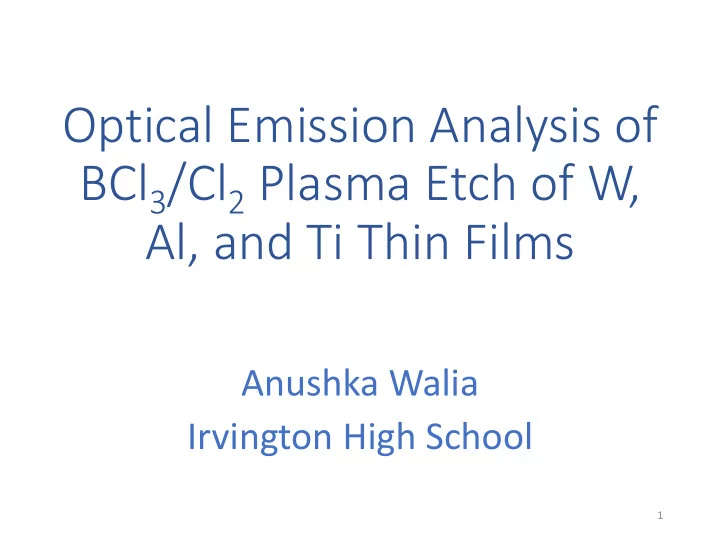

Optical Emission Analysis of BCl 3 /Cl 2 Plasma Etch of W, Al, and Ti Thin Films Anushka Walia Irvington High School 1
Centura MET (ICP chamber) • 2 Power sources • Inductively coupled source power through chamber wall • Platen Bias Power • Independent power sources allow lower pressure inside the chamber • More control of system ICP Platen 2
Mechanism MCl x Cl ions Metal (M) Si 1. RF power causes molecules to dissociate and form ions 2. Ions are accelerated downwards by bias power 3. Ions/Activated neutrals adsorbed Standard etch recipe (MET_AL_ME) onto surface of substrate, where reaction occurs 4. Product molecules are desorbed from the surface of the substrate and removed from the chamber (by bias power) 3
OES Technique • Technique used to determine elemental composition of samples • Utilizes unique emission spectra • Wavelength range: 160 – 770 nm 4
Mechanism 1. Electrons stripped by RF power, ionizing gas species 2. As electrons recombine with the ions, light emitted at specific wavelengths 3. Diffraction grating splits light 4. Detectors measure light intensity at different wavelengths – emission spectrum of atom/molecule Emission spectrum used to identify species present, intensity of light is used to measure relative concentrations 5
Multi-wavelength OES • Multi-wavelength OES can monitor multiple wavelengths instead of only 1-2 • Allows for investigation of secondary lines to confirm species • Can choose lines to maximize signal to noise ratio • Endpoint detection • Contaminant detection 6
Experimental Plan Goal: Optical emission analysis of species present in plasma etches of various materials • W/Si, W/SiO2, Ti/Si, Ti/SiO2, Al/Si, Al/SiO2 • Bare Si before and after each wafer • Monitor etch conditions using OES • Analysis of data • Baseline fingerprint of materials relevant to the etch • Identify useful wavelengths 7
MET setup • x2 2-meter Fiber Patch Cables from Thorlabs with range 200-1200 nm • Spectrophotometer • OceanView software Spectrometer MET Chamber C Computer USB Cable #2 Cable #1 8
Relevant Wavelength Data Species Wavelength AlCl3 (AlCl) 261, 265, 268 BCl3 (BCl) 272, 267 Cl2 309 SiCl4 (SiCl) 281,282,287 W 272 201 407 430 Ti 335 365 400 TiCl 419 9
Cl 2 on Bare Si SiCl Band 10
BCl 3 on Bare Si BCl 3 Band 11
Al/Si Al / AlCl peaks SiCl Band 12
Al/Si Endpoint 13
Al/SiO 2 Al peaks 14
Al/SiO 2 15
Why SiCl with Si but not SiO2? Al/SiO2 Al/Si • Si-O bond stronger than Si-Cl bond • B-O bond stronger than B-Cl bond 16
Ti/Si Ti peaks SiCl band 17
Ti/Si 18
Ti/SiO 2 Ti peaks 19
Ti/SiO 2 20
W/Si SiCl band W peaks W peaks 21
1000 1200 1400 1600 1800 W/Si 200 400 600 800 0 00:00.0 00:06.6 00:13.2 00:20.0 00:26.6 00:33.2 00:39.8 00:46.4 00:53.0 00:59.6 01:06.2 01:12.8 01:19.4 01:26.0 01:32.6 01:39.2 01:45.8 01:52.4 01:59.0 02:05.6 02:12.2 W/Si Timeseries 02:18.8 have clear endpoint W etch does not 02:25.4 02:32.0 02:38.6 02:45.2 02:51.8 02:58.4 03:05.0 03:11.6 03:18.2 03:24.8 03:31.4 endpoint >4 minutes to 03:38.0 03:44.6 03:51.2 03:57.8 04:04.4 04:11.0 04:17.6 04:24.2 04:30.8 04:37.4 04:44.0 506.999 (W) 22
W/SiO 2 W peaks 23
W/SiO 2 W etch does not have clear endpoint 24
Bare Si 25
W endpoints Boiling points of W chlorides Cl ions WCl4 Extremely high (solid at rt) WCl x WCl x WCl x WCl5 275.6 °C W Si WCl6 346.7°C Species with boiling points under ~300°C W chlorides do not get removed, at standard pressure will be removed, but act like a block => slow endpoints some W chlorides have bp above that 26
Recommendations • Wavelengths recommended for various etches: Al: 264, 311, 397 Ti: 418, 431, 455, 469, 502, 521 W: 507 • Do not run Cl based etch on W wafers Future testing • SF6 + O2 based etch for W • Check for cross contamination of S byproducts 27
Works Cited • “Stationary Metal Analyzers”, Ametek Materials Analysis Division • P5000 Endpoint Manual 28
Acknowledgements • Ryan Rivers • Jayss • Jesse • Cheryl • Marilyn • Bill Flounders 29
Recommend
More recommend